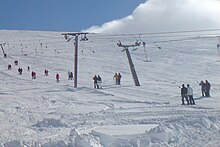
Back Telesquí AN مصعد الجر Arabic Telesquí Catalan Lyžařský vlek Czech Schlepplift German Telesquí Spanish Téléski French Sciovia Italian 滑走式リフト Japanese Влечница Macedonian

A surface lift is a type of cable transport for snow sports in which skiers and snowboarders remain on the ground as they are pulled uphill. While they were once prevalent, they have been overtaken in popularity by higher-capacity and higher-comfort aerial lifts, such as chairlifts and gondola lifts. Today, surface lifts are most often found on beginner slopes, small ski areas,[1] and peripheral slopes. They are also often used to access glacier ski slopes because their supports can be anchored in glacier ice due to the lower forces and realigned due to glacier movement.
Surface lifts have some disadvantages compared to aerial lifts: they require more passenger skill and may be difficult for some beginners (especially snowboarders, whose boards point at an angle different than the direction of travel) and children; sometimes they lack a suitable route back to the piste; the snow surface must be continuous; they can get in the way of skiable terrain; they are relatively slow in speed and have lower capacity.
Surface lifts have some advantages over aerial lifts: they can be exited before the lift reaches the top, they can often continue operating in wind conditions too strong for a chairlift; they require less maintenance and are much less expensive to install and operate.
- ^ "Technical Information for lifts". SkiLifts.org. Archived from the original on 2007-02-06. Retrieved 2007-04-16.